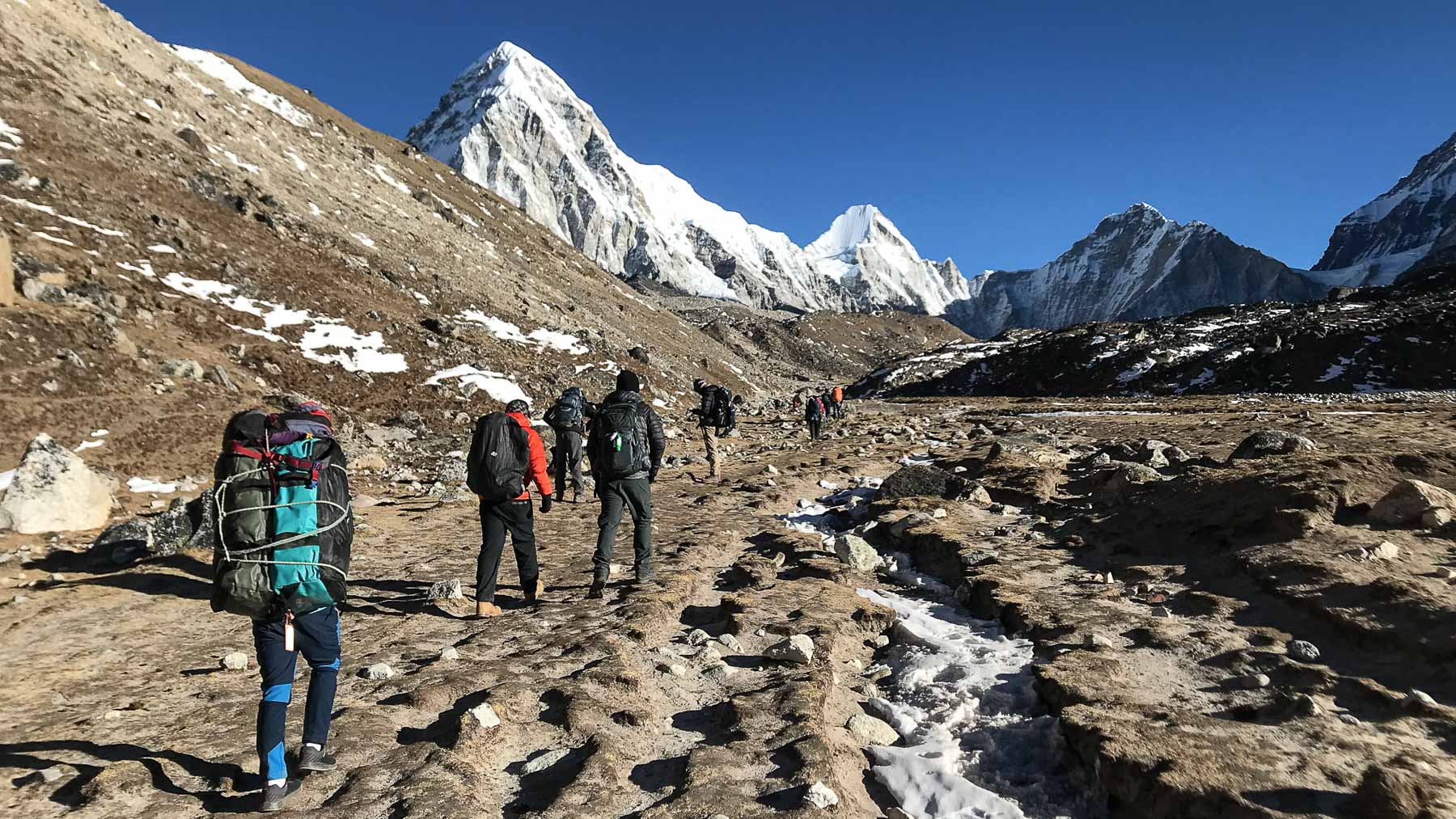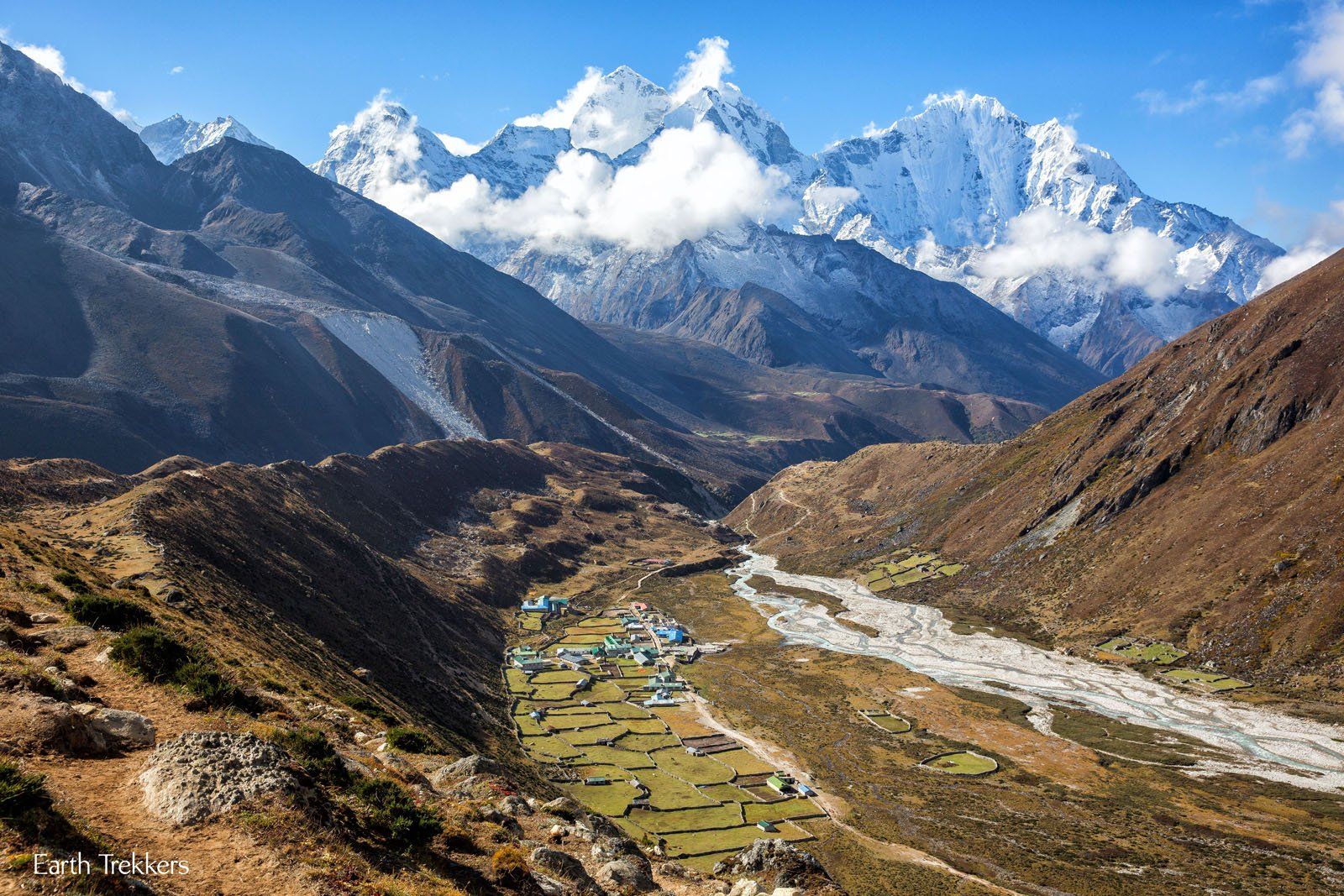1.1 Timeless Legacy of Everest
Nestled in Nepal’s Sagarmatha National Park, Everest Base Camp (EBC – 5,364 m) stands not only as the spiritual preview to Everest’s summit but as a global icon of adventure trekking, where hearts soar as feet treks.
1.2 Official Flourish: 12 Days on the Trail
Standard itineraries typically allocate 12 trekking days, augmented by 2–4 buffer days for flights or rest—total travel spans 14–16 days.
1.3 Primary & Alternate Routes
-
Classic Approach: Kathmandu → Lukla → Namche → Tengboche → Dingboche → Lobuche → Gorak Shep → EBC → Kala Patthar → descend via same route.
-
Variants: Add respite towns (Pheriche); loop via Renjo La or Gokyo Lakes; opt for a helicopter exit instead of trekking back.
2. 🏋️ Physical Conditioning: What You’re Up Against
2.1 Demands of Terrain & Elevation
This trek covers 100–130 km in 12 days, averaging 8–12 km/day, carrying 6–12 kg packs, and encountering steps, switchbacks, moraines, and variable surfaces.
2.2 Altitude Creep
From Lukla (2,800 m) to EBC (~5,364 m) and Kala Patthar (~5,500–5,555 m), altitude is the trek’s toughest foe—requiring meticulous acclimatization.https://highpasstreks.com/
2.3 Fitness Protocol
-
Cardio foundation: hill repeats, stairs, 3+ solid hikes
-
Strength regimen: core, lower body, endurance
-
Altitude conditioning: rest at elevation, staged ascent
-
Aim to minimize AMS risk by building stamina and respect for altitude.
2.4 Gear Up
Solid boots, poles, layers (thermal, fleece, down, shell), sleeping bag (-15 °C rating), headlamp, purification system, sunscreen, blister kits, oximeter, lightweight first-aid.https://highpasstreks.com/
3. ⛰️ Altitude: Strategy, Response & Safety
3.1 Altitude Zones
-
2,500–3,500 m: High altitude
-
3,500–5,500 m: Very high altitude
-
Above 5,500 m: Extreme altitude —tailored rest dates needed.
3.2 Acute Mountain Sickness (AMS)
Symptoms: headaches, nausea, breathlessness, fatigue
More serious: HAPE (fluid in lungs), HACE (cerebral edema)
Prevention: graded ascent, hydration, Diamox, meter tracking.https://highpasstreks.com/
3.3 Acclimatization Best Practices
-
“Climb high, sleep low” philosophy
-
Scheduled rest days (e.g., Namche, Dingboche)
-
Use oximeter, hydrate, supplement oxygen if needed
3.4 Emergency Protocols
Trained guides carry meds, oxygen; have helicopter evacuation plans. Comprehensive trekking insurance is imperative.https://highpasstreks.com/
4. 📦 Logistics & Permissions
4.1 Trailhead Access & Leeway
Fly Kathmandu–Lukla (~30–40 min), weather permitting; delays can force buffer days. Alternate overland via Ramechhap is possible.https://highpasstreks.com/
4.2 Permits
-
TIMS card
-
Sagarmatha National Park Permit
-
Point-of-entry fees (Trekking registration at Monjo/Namche)https://highpasstreks.com/
4.3 Support System
Licensed guide, porter (1 per 2 trekkers), often included in packages. Strongly advised—relieves load, offers cultural context, supports emergency response.
4.4 Accommodation & Dining
Teahouse twin rooms, basic facilities, hot shower/Wi‑Fi often charged extra (~USD 5). Food includes dal bhat, soups; around USD 5–10 per meal at high elevations.
4.5 Money & Connectivity
Cash in Kathmandu (USD to NPR), ATM in larger towns. Carry $200–300 for tea, snacks, shower, Wi‑Fi, tips. SIM cards or portable Wi‑Fi are helpful but patchy on trail.
5. 📅 Seasonal Windows & Weather
5.1 Seasonal Overview
-
Spring (Mar–May) and Autumn (Sept–Nov) are prime: clear skies, moderate temperatures, stable conditions.
-
Winter: cold and snowy but hush-filled and exclusive.
-
Monsoon: June–Aug rain and landslide risks—not recommended.
5.2 Weather at Elevation
Expect sharp diurnal swings: sunny lower valleys, minus degrees at altitude. Conditions are volatile—wind, storms, snow may come unannounced.
6. 🧘♂️ Cultural & Environmental Immersion
6.1 Sherpa Culture & Monasteries
Rich immersion includes Namche Bazaar crafts, Thame/Khunde prayer guidance, the ceremony at Tengboche monastery, and communal prayer flags adorning trails.https://highpasstreks.com/
6.2 Natural Reverence
From Rhododendron and Pine valleys to glacial expanses and EBC’s moraine, this region reveals ecological tapestry and climate fragility.
6.3 Leave-No-Trace Ethos
Pack out waste, minimize plastic use, respect sacred spaces; EBC area zero-tolerance rules—carry biodegradable bags, avoid single-use packaging.
7. 🛶 Financial Planning
7.1 Base Package Costs
Typical EBC trek (~12 days): USD 1,200–1,600, covering flights, permits, guide/porter, lodging, meals on trail.https://highpasstreks.com/
7.2 Additional Expenses
-
Hot showers/Wi‑Fi/battery charge: USD 5–10/day
-
Snacks, drinks, tips: USD 200–300
-
Kathmandu lodging & meals pre/post trek: USD 100–200
-
Insurance with heli-evac coverage: USD 100–200
7.3 Budget Estimation
-
All-inclusive expedition: USD 1,500–2,500
-
Formula: Base fee (1,400) + extras (300) + insurance (150) = ≈ USD 1,850https://highpasstreks.com/
8. 🏥 Health, Risk & Insurance
8.1 AMS & Altitude Emergencies
Recognize HAPE/HACE, enforce descent protocols. Diameter, rest, oxygen.
8.2 Injury Prevention
Boot fit, poles, blister prevention are survival. Alpine terrain demands alertness and careful pacing.
8.3 Insurance Coverage
Must explicitly cover high-altitude trekking (to 6,000 m) and heli-evacuations. Confirm permits for rescue.
9. 🧠 Psychological Fortitude
9.1 Loneliness, Motivation & Group Dynamics
Mental resilience tested on remote stretches—companionship and mindfulness ease the journey.https://highpasstreks.com/
9.2 Challenges & Growth
Hiking mid-mountain in above-5,000 m reduces distractions—leading to introspection and powerful inner journeys.
9.3 Reentry & Reflection
Post-trek, many experience reverse culture shock—plan resting days and mental calm after return.https://highpasstreks.com/
10. 🏅 Difficulty Rating & Comparisons
10.1 Overall Kickstarter
Rated moderate to difficult. No technical climbing, but light packs, long days, and high altitude make it challenging.
10.2 Critical Stressors
-
Rapid altitude gain
-
Variable terrain
-
6–10 hr trekking dayshttps://highpasstreks.com/
-
Psychosocial stressors
10.3 Comparisons
More strenuous than Annapurna Base Camp; less technical than climbing expeditions. Similar endurance demands to high-altitude hillmarathon routes.
11. 🧳 Gear & Resource Checklist
11.1 Essential Clothing Layers
-
Base: thermal top, bottom
-
Insulation: fleece, down jacket
-
Shell: waterproof/breathable jacket & pants
-
Accessories: hats, gloves, buff, socks (spare)
11.2 Footwear & Tools
-
Hiking boots (waterproof, sturdy)
-
Trekking poles
-
Crampons optional for pre-season snow
11.3 Night & Emergency
-
Sleeping bag rated –15 °C
-
Headlamp, power-bank
-
Medical kit: altitude meds, blister care, painkillers, antibiotics
11.4 Navigation & Communication
-
Maps.me, backup battery, local SIM
-
Satellite phone optional in emergencieshttps://highpasstreks.com/
12. 🧾 Permits & Regulatory Framework
-
TIMS card: Tracks visitors
-
Sagarmatha NP Permit
-
Local rural municipality permits/trail fees
Agencies often include these; independent trekkers should plan ahead.https://highpasstreks.com/
13. 🚁 Emergency Egress: Helicopter Solutions
-
Weather-permitting helicopter flights from Lukla or Pheriche for evacuations or exit
-
Operators coordinate landing, but insurance coverage and advance planning are essential
14. 🎒 Training & Preparation Timeline
-
3–6 months out: Cardio (hiking, running), strength
-
1–3 months: Overnight hikes with gear, test hikes with sleeping bag
-
2 weeks before trek: Light walks, easy routines
-
Pack trial runs to avoid surpriseshttps://highpasstreks.com/
15. 🌟 What You’ll Harvest
-
Immersive cultural tapestry, spiritual Sherpa connections
-
Epic glacial & mountain panoramas, including Khumbu Icefall
-
Life-changing mental challenge, rediscovery of endurance
-
Community: shared hardship, friendship, and collective triumph
-
Storytelling gold: a trek of self-awareness, courage, and humilityhttps://highpasstreks.com/
16. ✅ Action Checklist
-
Learn the trail facts: altitude, distance, seasons
-
Get fit & gear-ready
-
Book flights, permits, insurance
-
Plan buffer days & flexibility
-
Hire trustworthy guide/porter
-
Stock cash & small bills
-
Practice altitude strategy
-
Engage fully, respect cultures & environmenthttps://highpasstreks.com/













